Bright & Zesty Homemade Orange Marmalade Recipe
Crafting a vibrant homemade orange marmalade can transport you straight to sunny citrus groves with its bright, zesty flavors.
Sweet and tangy notes dance across your palate, capturing the essence of sun-ripened fruit.
Preserving seasonal oranges becomes an art form when you slice, simmer, and transform humble ingredients into a luxurious spread.
Each spoonful tells a story of careful preparation and culinary passion.
Spreadable sunshine awaits in this simple yet sophisticated recipe that turns ordinary mornings into extraordinary moments.
Your breakfast toast will never be the same after experiencing this delightful homemade preserve.
Grab a wooden spoon and let the marmalade magic begin!
Homemade Orange Marmalade Overview
What You Need for Orange Marmalade
Citrus Fruits:Sweetening Agents:Thickening Agents:Additional Ingredients:How to Make Homemade Orange Marmalade
Step 1: Prepare Citrus Fruits
Thoroughly wash oranges and lemon under cool running water.
Cut oranges into thin slices, carefully removing all seeds.
Slice the lemon into delicate pieces, keeping both the fruit and rind for maximum flavor extraction.
Step 2: Create Fruity Base
Transfer orange slices, lemon pieces, and citrus peels into a large cooking pot.
Pour water into the pot, ensuring all fruit is generously covered.
Allow the mixture to simmer gently over medium heat.
Step 3: Softening Citrus Mixture
Cook the fruit slowly for approximately one hour.
Watch as the liquid reduces and fruits become tender.
Stir occasionally to prevent sticking and ensure even cooking.
Step 4: Sweeten and Thicken
Add sugar and pectin to the softened fruit mixture.
Stir continuously until ingredients blend completely.
The mixture will start to transform into a glossy, rich texture.
Step 5: Develop Marmalade Consistency
Increase heat and bring the mixture to a rolling boil.
Continue cooking for about 30 minutes, stirring frequently.
The liquid will gradually thicken and develop a deep, vibrant color.
Step 6: Check Marmalade Readiness
Test marmalade’s consistency by dropping a small amount onto a chilled plate.
If the liquid sets and wrinkles when pushed, it has reached the perfect spreading texture.
Step 7: Preserve and Store
Carefully pour the hot marmalade into sterilized glass jars.
Seal jars tightly with clean lids.
Allow marmalade to cool completely at room temperature before storing in the refrigerator.
Tips for Perfect Marmalade Texture
Storing and Using Orange Marmalade
Serving and Pairing Ideas
Creative Marmalade Variations
FAQs
The combination provides a perfect balance of sweetness and tartness. Lemons contain natural pectin that helps the marmalade set and adds a bright, zesty flavor to the overall preserve.
While you can slightly reduce sugar, it plays a crucial role in helping the marmalade set and preserving the fruit. Cutting too much sugar might affect the texture and shelf life of the marmalade.
No special equipment is required. A large pot, sharp knife, and a few basic kitchen tools are all you need. Sterilized jars can be easily prepared by washing in hot, soapy water and drying in a low-temperature oven.
Use the cold plate test by placing a small amount of the hot marmalade on a chilled plate. If it wrinkles when you push it with your finger, it has reached the right setting point and is ready to be jarred.
Print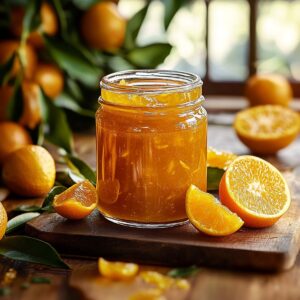
Delicious Homemade Orange Marmalade Recipe
- Total Time: 1 hour 45 minutes
- Yield: 10 1x
Description
Sweet citrus dreams come alive in this orange marmalade, a sunshine-packed preserve celebrating zesty Mediterranean flavors. Crafted with simple ingredients and patient technique, you’ll savor each bright, complex spoonful of homemade goodness.
Ingredients
Main Ingredients:
- 6 organic oranges
- 1 lemon
- 1 kilogram (2.2 pounds) sugar
Liquid:
- 1 liter (33.8 fluid ounces) water
Optional Ingredient:
- 1 packet pectin
Instructions
- Thoroughly cleanse oranges and lemon under cool running water, carefully removing any surface debris.
- Meticulously peel oranges, discarding white pith, and slice fruit into thin segments while extracting all seeds.
- Finely chop lemon and orange peels into delicate strips, ensuring uniform size for consistent texture.
- Transfer citrus peels, sliced fruits, and water into a large heavy-bottomed pot, creating a vibrant citrus base.
- Ignite medium-high heat, bringing liquid to a rolling boil, then reduce to gentle simmer for approximately 60 minutes until fruits soften and liquid reduces by half.
- Gradually incorporate sugar, stirring continuously to prevent scorching, allowing complete dissolution at consistent temperature.
- Add pectin if desired, mixing thoroughly to enhance setting properties and create smooth consistency.
- Elevate heat, returning mixture to vigorous boil for 25-30 minutes, stirring periodically to prevent burning.
- Conduct setting test by placing small dollop on chilled plate – marmalade should wrinkle when pushed with finger, indicating perfect consistency.
- Carefully ladle scorching hot marmalade into sterilized glass containers, leaving minimal headspace.
- Seal jars immediately, allowing natural cooling process to create secure vacuum seal.
Notes
- Always choose firm, ripe oranges with vibrant color for the most intense flavor and best texture in your marmalade.
- Use a sharp knife when slicing oranges and lemon to ensure thin, even cuts that will create a beautiful, consistent spread.
- Consider adding a splash of bourbon or Grand Marnier during the cooking process for an extra depth of flavor and sophisticated twist.
- When testing doneness, place a small plate in the freezer beforehand to ensure it’s completely cold, which helps the marmalade set more accurately.
- Prep Time: 15 minutes
- Cook Time: 1 hour 30 minutes
- Category: Snacks, Breakfast
- Method: Simmering
- Cuisine: British
Nutrition
- Serving Size: 10
- Calories: 137
- Sugar: 100 g
- Sodium: 1 mg
- Fat: 0 g
- Saturated Fat: 0 g
- Unsaturated Fat: 0 g
- Trans Fat: 0 g
- Carbohydrates: 101 g
- Fiber: 2 g
- Protein: 0.3 g
- Cholesterol: 0 mg

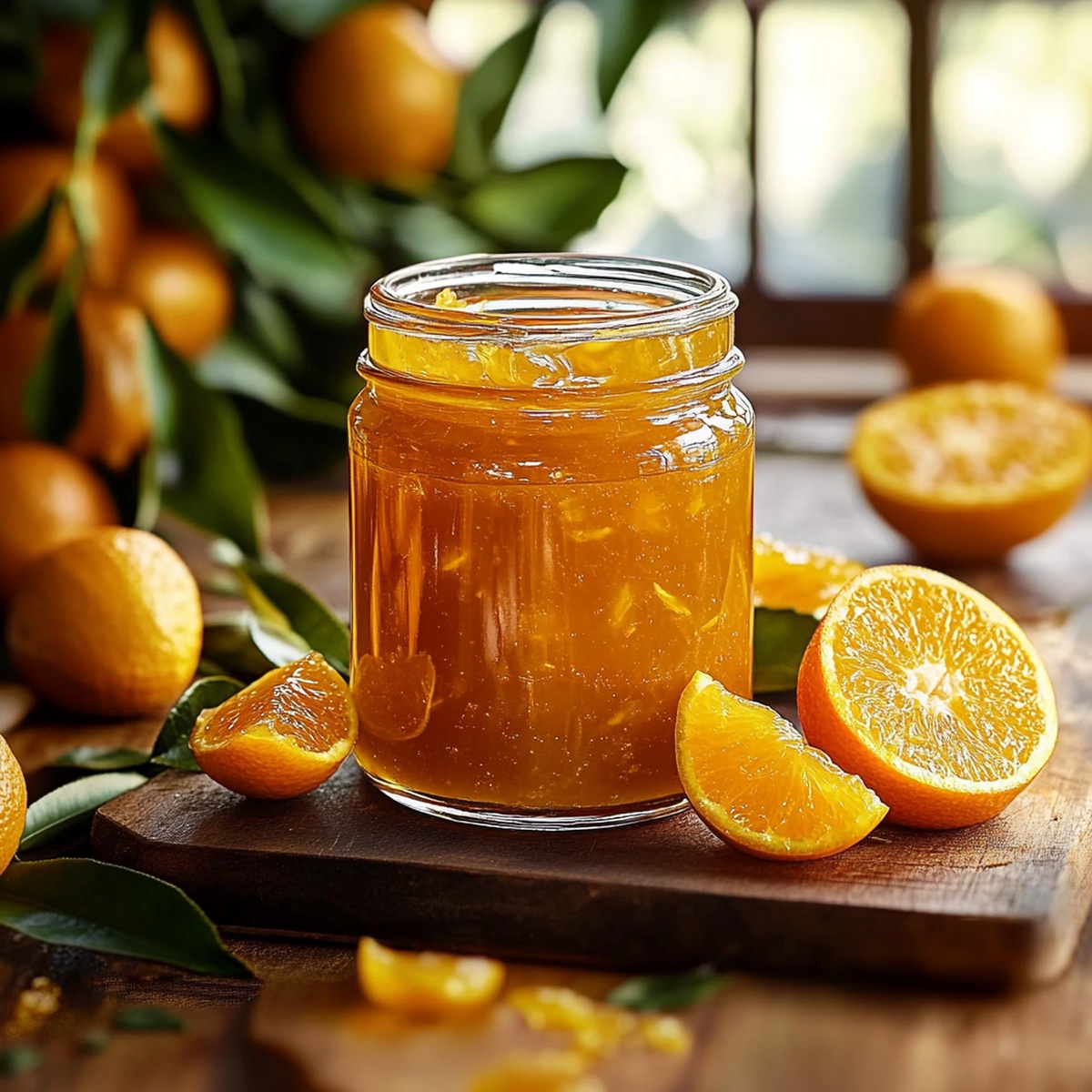
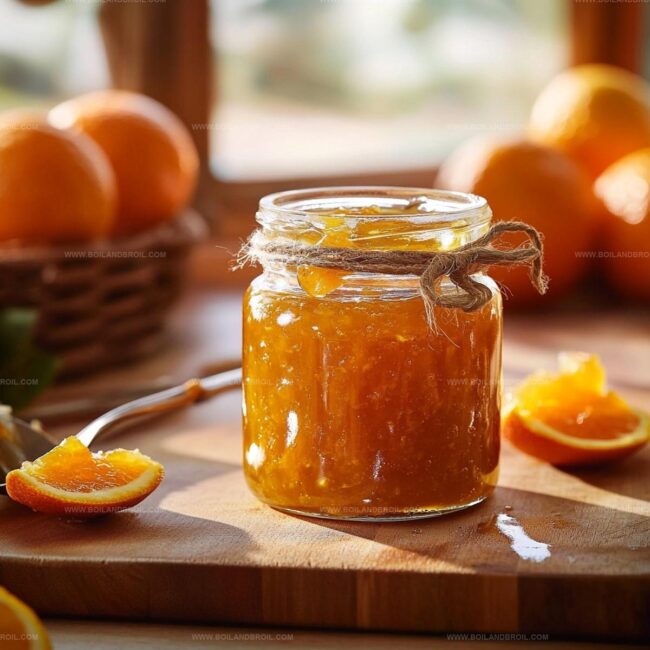
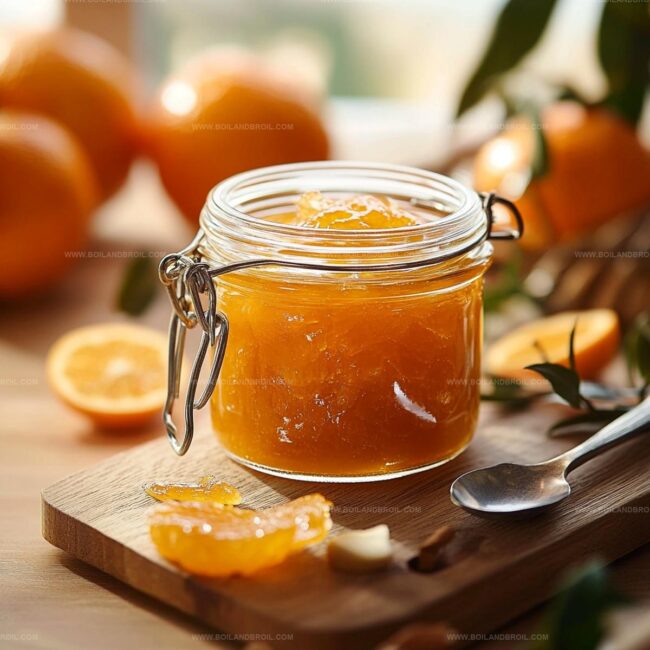
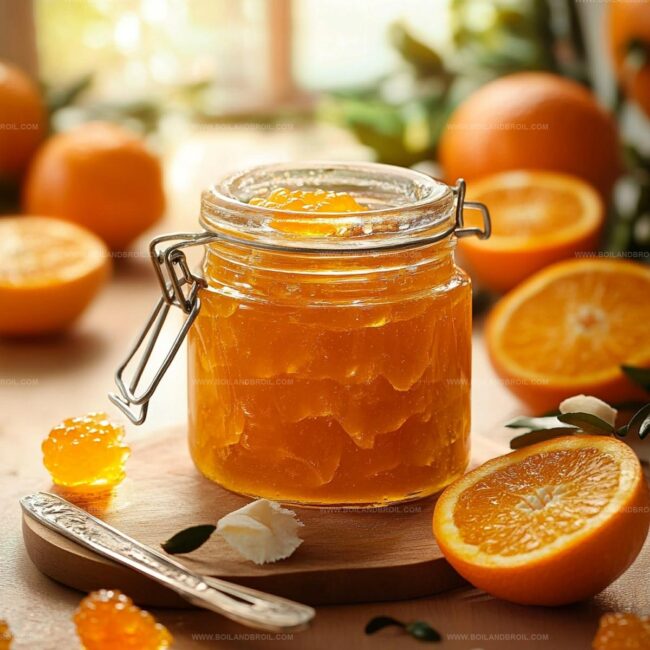
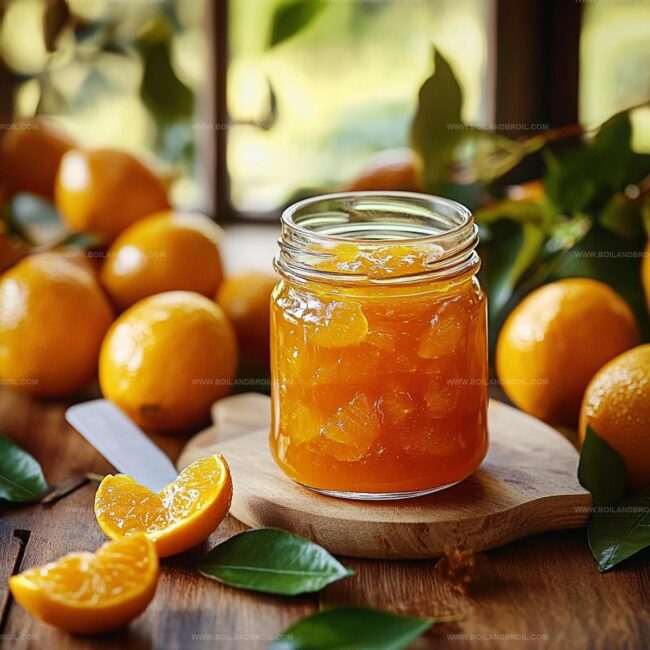
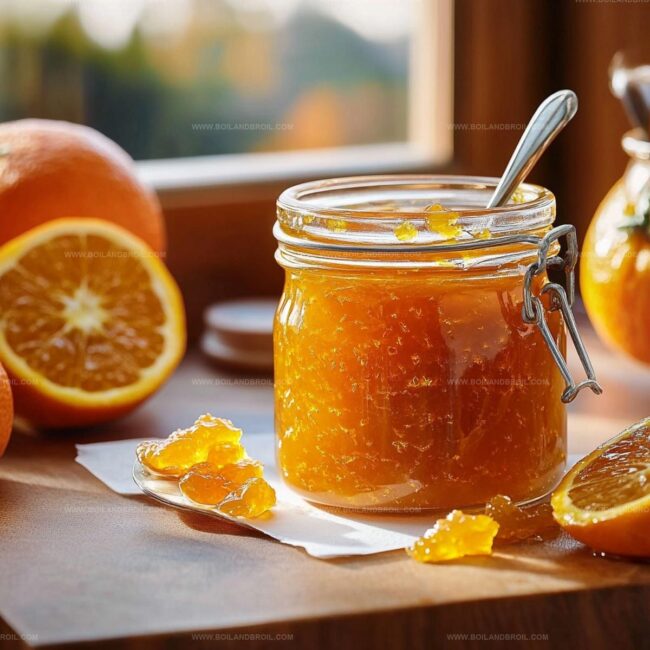
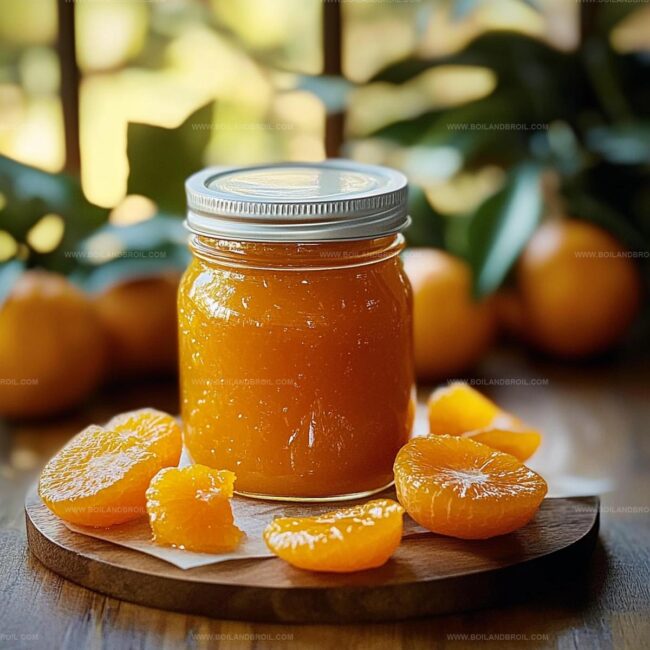
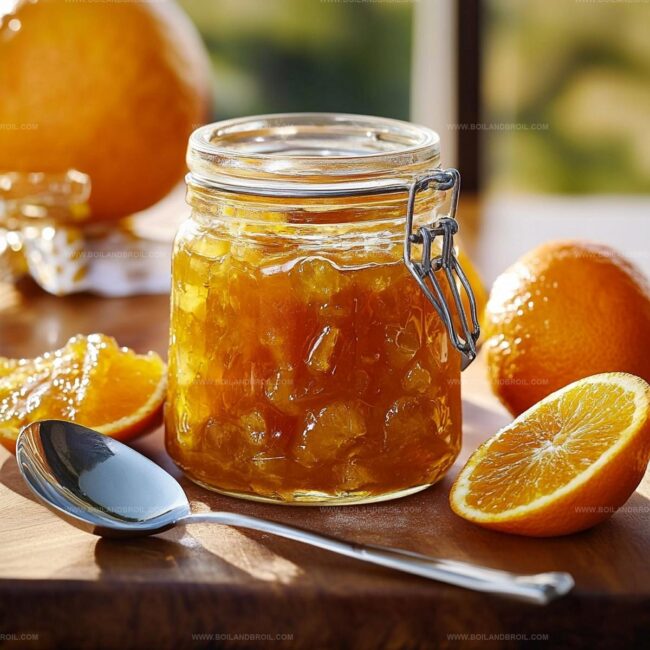
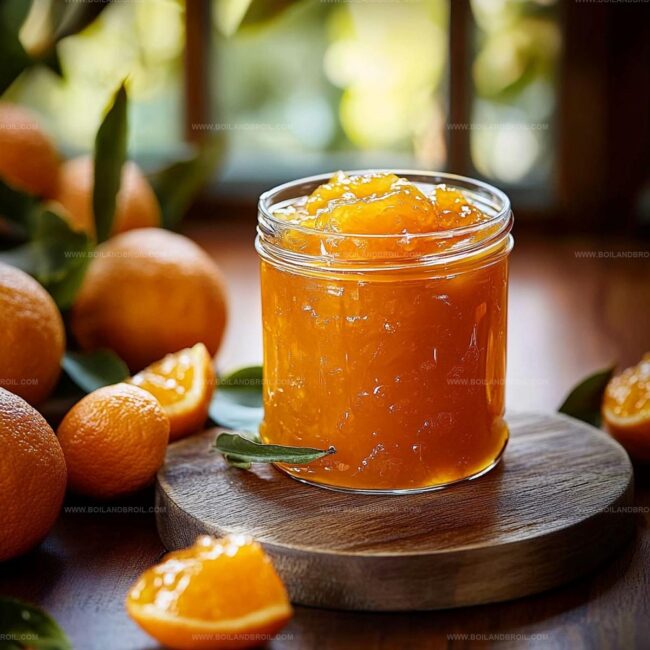
Jack Sullivan
Founder & Culinary Storyteller
Expertise
Single-recipe development with a narrative approach, Culinary storytelling and food history, Seasonal and regional ingredient utilization, Home cooking techniques adapted for modern kitchens
Education
New England Culinary Institute (Montpelier, VT)
Certificate in Culinary Arts
Focused on farm-to-table cooking, sustainable practices, and modern plating techniques.
Asheville-Buncombe Technical Community College
Associate Degree in Culinary Arts
Emphasized Southern Appalachian cuisine and local ingredient sourcing.
Jack grew up surrounded by smoky skillets and handwritten recipes in the mountains of North Carolina. His roots in Appalachian cooking shaped the way he sees food – as something that connects people, tells a story, and holds meaning.
With hands-on training and a background in sustainable, regional cooking, Jack started Boil And Broil to make meaningful meals more accessible. He’s all about one-dish recipes that are simple to follow but rich with flavor and history.